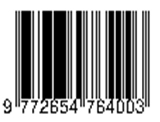ANALISIS EKSTRAK ASPERGILLUS SP. DALAM DENTURE ADHESIVE TERHADAP KEKUATAN TRANSVERSA RESIN AKRILIK DENGAN VIRULENSI Candida albicans
Abstract
Full Text:
PDF (Bahasa Indonesia)References
Anusavice K.J., Shen, C., Rawis, R.H., 2013.Phillips Science of dental materials, 12th ed., Elsevier Mosby.474-480.
Lamster, I.B., Northridge, M.E., 2008. Improving oral health for the ederly.Springer.31-32.
Power, J.M., Sakaguci, R.L., 2012.Craig’s Restorative Dental Materials, 13th ed., Elsevier Mosby, Philadelphia 162-91.
Zarb., Hobkirk., Eckert., Jacob., 2013. Prosthodontics treatment for edentulous patients: Completed denture and implant – supported prosthesis. 13 Ed. Elsevier. Mosby.133-47, 155-59.
Essam, A.A., Azza, A.A., Dina, E., Ali, E.M., 2010. Comparative study between different denture adesives in improving phonation in complete denture wearers. Journal of American Science.6:11.
Duqum, I., Powers, K.A., Cooper, L., Felton, D., 2012. Denture adesive use in complete dentures: Clinical recommendations and review of the literature. Gen Dent ;60(6):467-77.
Thalib, B., Purnama ,I., 2011.The comparison of body mass index of elderly used anddid not use full denture. J Dentofasial10(3):140-3.
Cooper, L.F., 2009. The current and future treatment of edentulism. J Prosthodont;18(2):116-122.
Rajaram, A., Manoj, S.S.,2017. Different forms of a commercially available denture adhesive material on the growth of Candida species: An in vitro study. J. Prosthet. Dent;1-7.
Nunes, E.M., Policastro, V.B., Scavassin, P.M., Leite, A.R, Medonza, Medonza, M.D.O., Giro, G.,2016. Crossover clinical trial of different methods of removing a denture adhesive and the influence on thhe oral microiota. J. Prosthet Dent;115:465-8
Almeida, N.L.,Saldanha,L.L., da Silva, R.A., 2017. Antimicrobial activity of denture adhesive associated with equisetum giganteum and punica granatum-enriches fraction against Candida alicans biofilms on acrylic resin surfarce. Biofouling The Journal of Bioadhesion and biofilm research. DOI: 10.1080/08927014.2017.1407408
Cartagana, A., Fesmerino, L.A., Junior, R.P., Parreiras, R.O., Michel, M.D., Farago, P.V., Campanha, N.H., 2016.New Denture adesive containing miconazole nitrate polymeric mickroparticle: Antifungal, adesive force And toxicity. Dental Material.
Semlali, A., Killer, K., Alanazi, H., Chmielewski, W., Rouabhia, M., 2014. Cigarette smoke condensate increases C. albicans adesion, growth, biofilm formation, and EAP1, HWP1 and SAP2 gene expression. BMC Microbiology, 14:61-61.
Craig, R.G., dan Powers, J.M., 2002. Restorative Dental Material. 11th ed. St Louis, MO, Mosby.636-89.
McCabe, John. F., Angus, W.G., Walls., 2008. Applied Dental Material. ed. 9th. London. Blackwell Scientific Publication. 110-120.
Maria, G.L., K.R., Sridhar, N.S., Raviraja., 2005. Antimicrobial and enzyme activity of mangrove endophytic fungi of southwest coast of India. Journal of Agricultural Technology. 1: 67-80
Rival, H., Handayani, D., Rasyid, R., 2018. Screening of antimicrobial and cytotoxic activities of endophytic fungi isolated frrom mangrove plant Rhizophora mucronata Lam. Int.Journal of Pharmaceutical Science and Medicine (IJPSM),Vol.3(3):9-20
Strobel, G.A. Daisy, B., 2003. Bioprocessing for microbial endophytes and their natural products. Microbiology and Molecular Biology Review. 67(4), 491- 502,
Fadriyanti. O. Gc-Ms Analysis Of Volatile Active Compounds Isolated From Aspergillus Sp Of Rhizophora Mucronata, Rasayan J. Chem, Vol 12 No 4October-December 2019
Silva, M.J., de Oliveira, D.G., Marcillo, O.O., Neppenlenbroek, K.H., Lara, V.S., Porto, V.C., 2016. Effect of denture-coating composite on Candida alicans biofilm and surface degradation after desinfection protocol. Int Dent J. 66:86-92.doi:10.1111/idj.2016.66.issue-2
Darwish, M., Nassani, M.Z., 2016. Evaluation of the Effect of Denture Adesive on Surface Roughness of Two Chemically Denture Base Resins. Eur J. Dent.10(3):321-328.
Camila, C., de Foggi., Ana, L., Machado., Camila, A., Zamperini., Darcy, F., AmandaF.,Wady. 2014. Effect of surface roughness on the hydrophobicity of a
Valli, G., Geetha, S., 2010. Insilico Prediction of Bio-Activity of Flavonoids Present in Erythrina Varigata. Journal of Science, 106(3), 2010–2010. https://doi.org/10.1016/j.apradiso.2014.09.019
Shirzad, M., Sardari, S., 2018, Synthesis and Characterization of Alkyne Derivatives as Antifungal Agents, Organics and Medicinal chemistry, 7(3), 3–4.
Dineshkumar, G. And Rajakumar, R. 2015. GC-MS Evaluation of Bioactive Molecules from the Methanolic Leaf Extract of Azadirachta indica. Asian Journal of Pharmaceutical Science & Technology, 5(2), 64-69
Jegadeeswari, P., Nishanthini, A., Muthukumaraswamy, S., Mohan, V. R. 2012. GC- MS Analysis of Bioactive Components of Aristolochia krysagathra (Aristolochiaceae). Journal Chemical Pharmaceutical Science, 2, 226-236.
Klingberg, F., Hinz, B., White, E. S., 2013. The myofibroblast matrix: implications for tissue repair and fibrosis. The Journal of pathology, 229(2),298-309.
Pinheiro, C. R., Coelho, A. L., de Oliveira, C. E., Gasp.aroto, T. H., Garlet, G. P., Silva, J. S., Campanelli, A. P., 2018. Recognition of Candida albicans by gingival fibroblasts: The role of TLR2, TLR4/CD14, and MyD88. Cytokine, 106, 67-75. doi:10.1016/j.cyto.2017.10.013.
Tamai, R., Sugamata, M., Kiyoura, Y., 2011. Candida albicans enhances invasion of human gingival epithelial cells and gingival fibroblasts by Porphyromonas 459.
Mekkawy, M., Hussein, L., Alsharawy, M., 2015. Comparative study of surface roughness between polyamide, termoplastic polymethyl methacrylate and acetal resins flexible denture base materials before and after polishing. Life ScienceJournal.12:90-5.
Febrianoca, V., Hendrawati, T.Y., Handayani, W., 2017. Pengaruh suhu terhadap kandungan asam palmitat pada proses fraksinasi palm stearin, Prosiding Semnastek, 1-7
Yunita, I.K., Rostiny., Djulaeha, E., 2014. Efek denture adesive terhadap kekuatan transversa lempeng akrilik heat cured. J of Prosthodontic.5(1): 10-15.
Porwal, A., 2017 Effect of denture cleansers on color stability, surface roughness, and hardness of different denture base resins. Journal of Indian Prosthodontic Society. 17(1):61-7.
Shirzad, M., Sardari, S., 2018, Synthesis and Characterization of Alkyne Derivatives as Antifungal Agents, Organics and Medicinal chemistry, 7(3), 3–4.
DOI: https://doi.org/10.33854/jbd.v9i2.1234
DOI (PDF (Bahasa Indonesia)): https://doi.org/10.33854/jbd.v9i2.1234.g445
Refbacks
- There are currently no refbacks.
Copyright (c) 2022 Okmes Fadriyanti

This work is licensed under a Creative Commons Attribution-NonCommercial-ShareAlike 4.0 International License.




